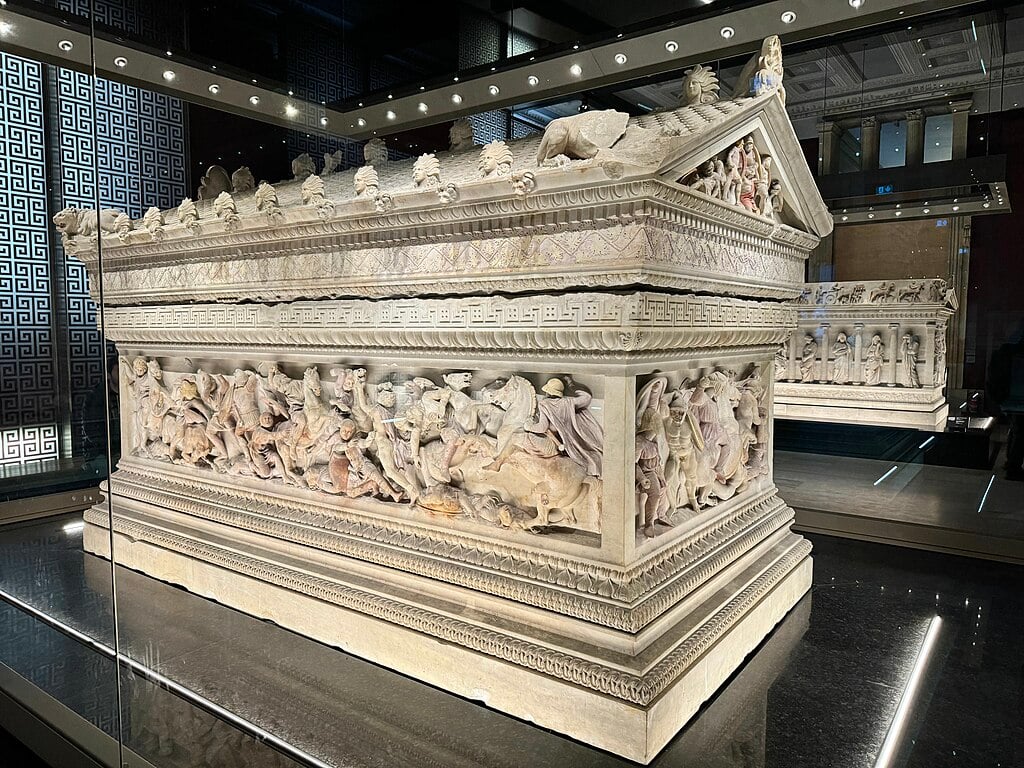

Contrary to what its name might suggest, the Alexander Sarcophagus, a marvel of Greek artistry, does not house the body of Alexander the Great, but of an obscure man named Abdalonymos.
In the late 4th century BC, as the known world trembled under the boots of Alexander the Great, a curious twist of fate unfolded in the ancient Phoenician city of Sidon.
Abdalonymos, once a humble gardener of noble but forgotten lineage, found himself plucked from obscurity and crowned king. His life—and death—would be immortalized in one of the most breathtaking funerary monuments of antiquity: the Alexander Sarcophagus.
The Alexander Sarcophagus, which is housed in an Istanbul museum, does not house the body of Alexander the Great. Indeed, the whereabouts of the great general’s final resting place remains one of history’s tantalizing mysteries. Instead, this sarcophagus was crafted for the man Alexander elevated to king.
After Alexander’s conquest of Sidon in 332 BC, the city found itself in need of a new ruler. When asked to choose, the Macedonian conqueror was told of a man of royal blood, now reduced to tending gardens outside the city walls. Moved by this tale, Alexander summoned Abdalonymos and, in a striking gesture of pragmatism and romanticism, placed a crown upon his head. Thus began the gardener’s reign.
Years later, perhaps as a declaration of legitimacy or a monument to his extraordinary fortune, a sarcophagus was commissioned. Between 325 and 315 BC, artisans shaped Pentelic marble—the same luminous stone used for the temples of the Acropolis—into a funerary masterpiece. The result was unlike anything the ancient world had seen.
The sarcophagus is a marvel of Greek artistry, resembling a miniature temple with its pitched roof adorned in tile-like patterns and intricate friezes. But it is the reliefs carved into its flanks that have captured imaginations for over two millennia.

On one long side, Alexander is shown in the thick of battle, likely at Issus in 333 BC. He rides without a helmet, his features unmistakable beneath a lion-skin cap—a nod to Heracles, the hero from whom his family claimed descent. The Persians fall before him, the scene alive with tension and triumph.
On the opposite side, Alexander and Abdalonymos appear together again, not in war, but in the noble pursuit of the hunt. Lions and panthers leap in marble fury, while Macedonian and Persian nobles ride side by side. In these carvings, war gives way to harmony; East and West are no longer foes, but partners in shared valor.
Polychromy—now faint—once brought these scenes to vibrant life. Colors once danced along the armor, the steeds, the flesh of hunter and hunted. It was not merely a tomb, but a theater of stone, a visual manifesto declaring loyalty, legitimacy, and glory.

More than two thousand years later, in 1887, the sarcophagus emerged from the darkness once more. Buried deep within the Royal Necropolis of Ayaa near Sidon, it was unearthed by Osman Hamdi Bey, a pioneering Ottoman archaeologist, museum director, and painter. His excavations were among the first scientific digs led by an Ottoman team and marked a turning point in how the empire treated its ancient heritage.
The discovery of the Alexander Sarcophagus—alongside others such as the hauntingly beautiful Sarcophagus of the Mourning Women—was so momentous that it led to the creation of a new home for them: the Istanbul Archaeology Museum, which Hamdi Bey himself would lead. He championed laws to protect antiquities from being smuggled abroad, laying the foundation for modern cultural preservation in the region.
